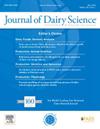您准备好迎接挑战了吗?性格特征影响奶牛对疾病、疼痛和营养挑战的反应。
IF 3.7
1区 农林科学
Q1 AGRICULTURE, DAIRY & ANIMAL SCIENCE
引用次数: 0
摘要
奶牛犊牛在生命早期经常会经历疾病、疼痛和营养压力,如腹泻、去角和断奶。这些应激会导致不同个体的行为表现发生变化,变化幅度越大,表明个体对应激的适应能力越低。因此,本研究首先旨在量化个体在应对腹泻、去角和断奶时在采食行为和活动方面的变化幅度。下一个目标是研究个性特征是否与奶牛犊牛的行为反应幅度有关,从而研究它们对这些压力的适应能力。犊牛使用两种精确畜牧技术(例如:自动饲喂系统(AFS)和腿部加速度计)进行跟踪,以了解犊牛在应激因素存在期间的行为反应变化。自动饲喂系统每天测量犊牛的牛奶摄入量、饮水速度、对牛奶饲喂站的奖励和未奖励访问,以及犊牛的开食量。腿部加速度计每天测量步数、活动指数、躺卧时间和躺卧次数。23±3日龄时,荷斯坦奶牛犊牛(n = 49)接受了一系列标准化性格测试,这些测试使犊牛受到新奇和恐惧刺激。从性格测试行为的主成分分析中提取的因子被用来代表性格特征:因子 1("恐惧")、因子 2("活跃")和因子 3("探索")。相对于应激源发生当天(即诊断当天、去角当天、断奶当天)的行为,计算了家畜精准饲养技术的行为变化幅度。利用线性回归模型来确定犊牛在每个因素上的得分是否与每个应激期的行为变化幅度相关,并将相对于应激期的天数作为重复测量值。模型在每种应激前和应激后分别独立运行。我们发现,尽管犊牛在相同的环境中饲养,并经历了一致的管理程序,但它们对腹泻、去角和断奶应激的行为反应却各不相同。此外,通过标准化测试测得的个性特征与每种应激源的行为变化方向和幅度都有关联。例如,在腹泻时,高度 "恐惧 "的犊牛在诊断后的采奶量和饮水速度的变化幅度要大于最不 "恐惧 "的犊牛。在断角时,"探索性 "强的犊牛在断角时的躺卧时间变化幅度较大,但断角后躺卧次数和饮水速度的变化幅度小于 "探索性 "弱的犊牛。断奶时,"好动 "程度高的犊牛在断奶前和断奶后的无回报探视次数的变化幅度要小于 "好动 "程度最低的犊牛。每种性格特征都与围绕每种压力源的行为变化有显著关联,但这些关联取决于压力源的类型。这些结果对每头犊牛如何经历每种应激源以及个体动物福利都有影响。本文章由计算机程序翻译,如有差异,请以英文原文为准。
Are you ready for a challenge? Personality traits influence dairy calves' responses to disease, pain, and nutritional challenges
Dairy calves routinely experience disease, pain, and nutritional stressors such as diarrhea, dehorning, and weaning early in life. These stressors lead to changes in behavioral expression that varies in magnitude between individuals, where a greater magnitude change would suggest lower resilience in individuals to a stressor. Thus, this study first aimed to quantify the individual variation in magnitude change in feeding behaviors and activity in response to a bout of diarrhea, dehorning, and weaning. The next objective was to then investigate if personality traits were related to this magnitude of behavioral response in dairy calves, and thus their resilience toward these stressors. Calves were followed with 2 precision livestock technologies (e.g., an automatic feeding system, and leg accelerometer) to track behavioral changes in response during the time when the stressors were present. The automatic feeding system provided daily measures of milk intake, drinking speed, rewarded and unrewarded visits to the milk feeding station, and calf starter intake. The leg accelerometer provided daily measures of steps, activity index, lying time, and lying bouts. At 23 ± 3 d of age, Holstein dairy calves (n = 49) were subjected to a series of standardized personality tests that exposed the calf to novelty and fear stimuli. Factors extracted from a principal component analysis on the behaviors from the personality test were interpreted as personality traits: Factor 1 (fearful), Factor 2 (active) and Factor 3 (explorative). The magnitude changes in behaviors from the precision livestock technologies were calculated relative to the behavior performed on the day the stressor occurred (i.e., day of diagnosis, day of dehorning, day weaned). Linear regression models were used to determine whether calf scores on each factor were associated with magnitude change in behavior for each of the stressor periods with day relative to the stressor included as a repeated measure. Models were run independently for the period leading up to and following each stressor. We found that calves varied in their behavioral responses to diarrhea, dehorning, and weaning stressors, despite being reared in the same environment and experiencing consistent management procedures. Additionally, personality traits measured from standardized tests were associated with both the direction and magnitude of change in behaviors around each stressor. For instance, with diarrhea, calves that were highly fearful had a greater magnitude change in milk intake and drinking speed following diagnosis than the least fearful calves. With dehorning, calves that were highly explorative had a greater magnitude change in lying time when dehorned, but a smaller magnitude change in lying bouts and drinking speed following dehorning, compared with the least explorative calves. With weaning, calves that were highly active had a smaller magnitude change in unrewarded visits leading up to and following weaning than calves that were the least active. Each of the personality traits had a significant association with change in behavior surrounding each of the stressors evaluated, although these associations depended on the type of stressor. These results have implications for how individual calves experience each stressor and therefore individual animal welfare.
求助全文
通过发布文献求助,成功后即可免费获取论文全文。
去求助
来源期刊

Journal of Dairy Science
农林科学-奶制品与动物科学
CiteScore
7.90
自引率
17.10%
发文量
784
审稿时长
4.2 months
期刊介绍:
The official journal of the American Dairy Science Association®, Journal of Dairy Science® (JDS) is the leading peer-reviewed general dairy research journal in the world. JDS readers represent education, industry, and government agencies in more than 70 countries with interests in biochemistry, breeding, economics, engineering, environment, food science, genetics, microbiology, nutrition, pathology, physiology, processing, public health, quality assurance, and sanitation.
 求助内容:
求助内容: 应助结果提醒方式:
应助结果提醒方式:


